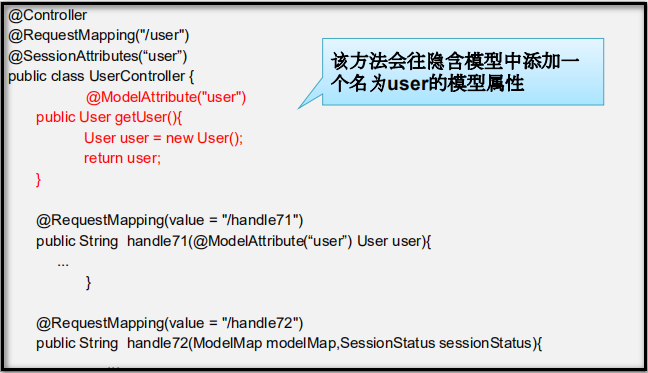处理模型数据
Spring MVC 提供了以下几种途径输出模型数据:
– ModelAndView: 处理方法返回值类型为 ModelAndView时, 方法体即可通过该对象添加
模型数据
– Map 及 Model: 入参为org.springframework.ui.Model、org.springframework.ui.
ModelMap 或 java.uti.Map 时,处理方法返回时,Map
中的数据会自动添加到模型中。
– @SessionAttributes: 将模型中的某个属性暂存到
HttpSession 中,以便多个请求之间可以共享这个属性
– @ModelAttribute: 方法入参标注该注解后, 入参的对象就会放到数据模型中
注:下面的代码均来自上一篇的注解代码之后的测试代码!!
ModelAndView
控制器处理方法的返回值如果为 ModelAndView, 则其既
包含视图信息,也包含模型数据信息。
添加模型数据:
– MoelAndView addObject(String attributeName, Object
attributeValue)
– ModelAndView addAllObject(Map<String, ?> modelMap)
设置视图:
– void setView(View view)
– void setViewName(String viewName)
TestRequestMapping.java
@RequestMapping("/testModelAndView")
public ModelAndView testModelAndView(){
String viewName="success";
ModelAndView andView = new ModelAndView(viewName);
andView.addObject("time", new Date());
return andView;
}
index.jsp
<a href="springmvc/testModelAndView">testModelAndView</a>
success.jsp;
time:${requestScope.time}
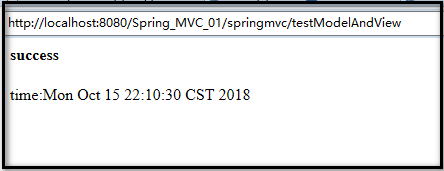
总结:SpringMVC会把ModelAndView的model中数据放入到request域对象中
Map 及 Model
Spring MVC 在内部使用了一个org.springframework.ui.Model 接口存储模型数据
具体步骤
– Spring MVC 在调用方法前会创建一个隐含的模型对象作为模型数据的存储容器。
– 如果方法的入参为 Map 或 Model 类型,Spring MVC 会将隐含模型的引用传
递给这些入参。在方法体内,开发者可以通过这个入参对象访问到模型中的所有数
据,也可以向模型中添加新的属性数据
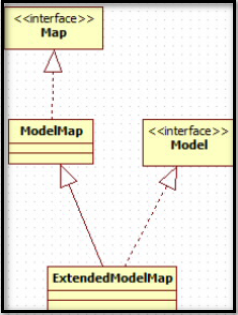
目标方法可以添加Map类型(实际上是Model或者ModelMap类型)的参数
TestRequestMapping.java
@RequestMapping("/testMap") public String testMap(Map<String, Object> map){ map.put("name", "MrChengs"); return "success"; }
indexjsp
<a href="springmvc/testMap">testMap</a>
success.jsp
name:${requestScope.name}

@SessionAttributes
只能放在类的上面
若希望在多个请求之间共用某个模型属性数据,则可以在
控制器类上标注一个 @SessionAttributes, Spring MVC
将在模型中对应的属性暂存到 HttpSession 中。
@SessionAttributes 除了可以通过属性名指定需要放到会话中的属性外(value)
还可以通过模型属性的对象类型指定哪些模型属性需要放到会话中(type)
– @SessionAttributes(types=User.class) 会将隐含模型中所有类型
为 User.class 的属性添加到会话中。
– @SessionAttributes(value={“user1”, “user2”})
– @SessionAttributes(types={User.class, Dept.class})
– @SessionAttributes(value={“user1”, “user2”},
types={Dept.class})
TestRequestMapping.java
@SessionAttributes(value="user") @Controller @RequestMapping("/springmvc") public class TestRequestMapping { @RequestMapping("/testSessionAttributes") public String testSessionAttributes(Map<String,Object> map){ User user = new User("MrChangs", "1234", "1287@qq.com"); map.put("user", user); return "success"; } }
index.jsp
<a href="springmvc/testSessionAttributes">testSessionAttributes</a>
success.jsp
user requestScope:${requestScope.user}
<br>
<br>
user sessionScope:${sessionScope.user}
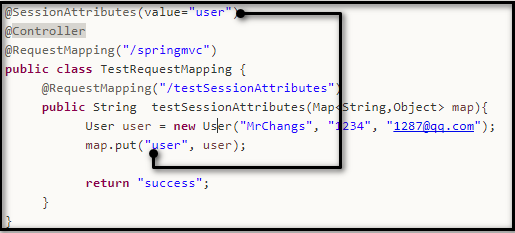

@ModelAttribute
模拟修改数据路中的数据,有些不能修改。
index.jsp
<!--
模拟修改操作
1.原始数据:id=1,name=MrChengs,pw=1234,email=MrChengs@qq.com
2.密码不能修改
3.表单回显,模拟操作直接在表单填写对应的额属性值
-->
<form action="springmvc/ModelAttribute" method="post">
<input type="hidden" name="id" value="1">
<br>
name:<input type="text" name="username" value="MrChengs">
<br>
email:<input type="text" name="email" value="MrChengs@qq.com">
<br>
<input type="submit" value="submit">
</form>
//标记的方法会在每个目标方法执行之前被调用
//1.由@ModelAttribute标记的方法,会把每个目标之前被springmvc调用
//2.@MOdelAttribute注解也可以来修饰目标方法pojo类型的入参,其value属性值如下作用
//2.1)springmvc会使用value属性值在implicitModel中查找对应的对象,若存在直接传入到目标方法的入参中
//2.2)springmvc会把value为key,pojo类型对象为value,存到request中
@ModelAttribute
public void getUser(@RequestParam(value="id",required=false) Integer id,
Map<String,Object> map){
if(id != null){
User user = new User(1, "MrChengs", "1234", "MrChengs@qq.com");
System.out.println("得到一个参数");
//注意:这里的key为users,如果改为users等其他字符,等不到结果,程序可以正常的执行
//解决方法在下面的代码中
map.put("users", user);
}
}
@RequestMapping("/ModelAttribute")
public String testModelAttribute(@ModelAttribute("users")User user){
System.out.println("update:" + user);
return "success";
}
在success页面:
可以使用如下的方法获得打印值
user:${requestScope.users}
如果不添加@ModelAttribut,在测试中代码的值为null

运行过程:
1.执行@ModelAttribute注解修饰的方法,把数据取出防砸map中,map的key为user
2.SpringMVC从Map中取出User对象,并把表单请求参数放到赋给给该user对象多的对应属性
3.SpringMVC把上述对象传入目标方法的参数
注意:在MOdelAttribute修饰的方法中,放入map的键需要和入参第一个字母小写的字符串一致
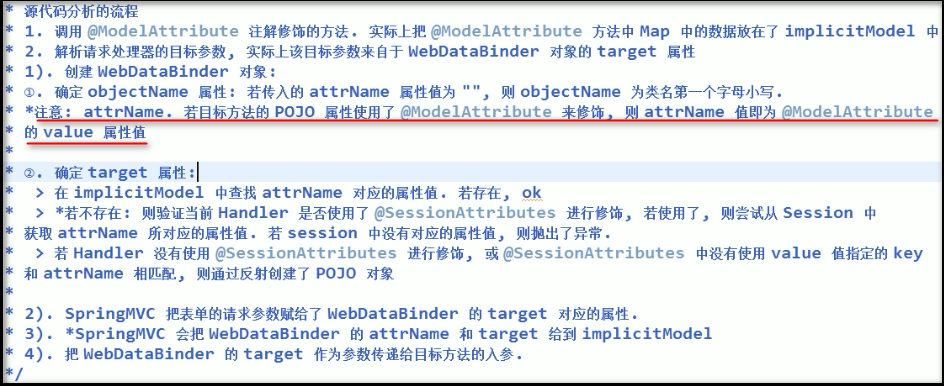
SpringMVC确定目标方法POJO类型入参的过程:
1.确定一个key
2.在implicitModel中查找对应的key对象,若存在,则作为入参传入
3.在implicitModel中不存在key对象,则查找当前的Handler,是都使用了@SessionAttribute对应的 value值若存在则直接传入到方法的入参中,不存在抛异常
4.若Handler没由标识的@SessionAttribute注解或者@Session Attribute的value值不包含key,则会通过 反射来创建pojo类型的参数,作为目标方法的参数
5.SpringMVC会把key和value保存到impliciModel中,进而会保存早request中
关于@SessionAttribute的异常
java类:
注意这里@SessionAttribute(user)和方法中的user同名
@SessionAttributes(value="user") @Controller @RequestMapping("/springmvc") public class TestRequestMapping { @RequestMapping("/ModelAttribute") public String testModelAttribute(User user){ System.out.println("update:" + user); return "success"; } }
在ModelAttribute方法的user
没找到就去@SeeionAttribute中找
所以此时会报错----抛异常
解决方案:
1.写ModelAttribute注解下的方法
2.表明一个modelAttribute,在第一次查找中赋值,不在第二次找SeesionAttribute
public String testModelAttribute(@ModelAttribute("acbc")User user){
十月 16, 2018 4:38:06 下午 org.apache.catalina.core.StandardWrapperValve invoke
严重: Servlet.service() for servlet [springDispatcherServlet] in context with path [/Spring_MVC_01] threw exception [Session attribute 'user' required - not found in session] with root cause
org.springframework.web.HttpSessionRequiredException: Session attribute 'user' required - not found in session
at org.springframework.web.servlet.mvc.annotation.AnnotationMethodHandlerAdapter$ServletHandlerMethodInvoker.raiseSessionRequiredException(AnnotationMethodHandlerAdapter.java:791)
@ModelAttribute
在方法定义上使用 @ModelAttribute 注解:Spring MVC
在调用目标处理方法前,会先逐个调用在方法级上标注了
@ModelAttribute 的方法。
在方法的入参前使用 @ModelAttribute 注解:
– 可以从隐含对象中获取隐含的模型数据中获取对象,再将请求参数定到对象中,再传入入参
– 将方法入参对象添加到模型中
由@SessionAttributes引发的异常
org.springframework.web.HttpSessionRequiredExcept: Session attribute 'user' required - not found in session
如果在处理类定义处标注了@SessionAttributes(“xxx”),则尝试从会话中获取该属性,并将其赋给该入参,然后再用
请求消息填充该入参对象。如果在会话中找不到对应的属性,则抛出 HttpSessionRequiredException 异常

如何避免@SessionAttributes引发的异常
